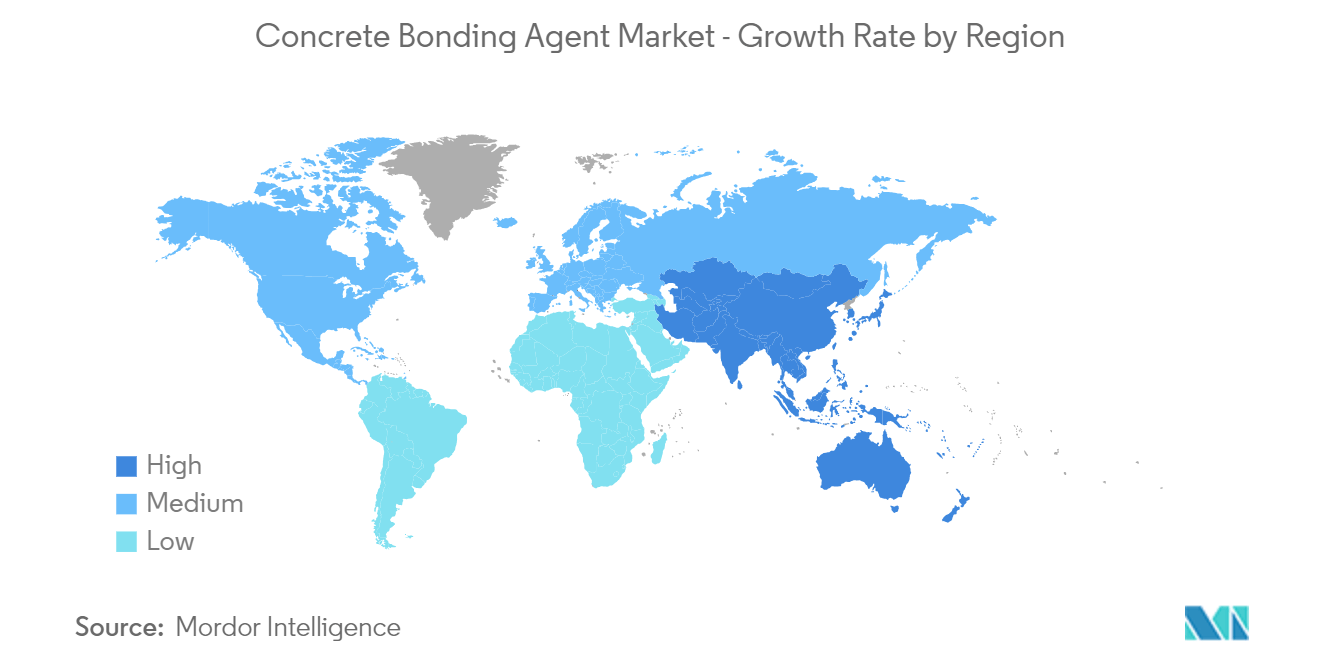Market Trends of Concrete Bonding Agent Industry
Increasing Demand from the Building and Construction Sector
- In building and construction, these bonding agents are used for repairing, flooring, decorating, and a few other applications, which, in turn, help renovate the buildings.
- These bonding agents improve cohesion. Its positive adhesion exceeds that of the tensile strength of the host concrete.
- The building and construction sector leads the way in applying concrete bonding agents. The increasing residential construction and renovation activities in developing countries are increasing the demand for concrete bonding agents.
- The Chinese government has rolled out massive construction plans, including making provisions for the movement of 250 million people to its new megacities over the next ten years.
- The US Census Bureau has been providing more permits for constructing new residential buildings due to the current trend of multi-family buildings and a rise in migration to cities.
- According to the US Census Bureau, the value of completed commercial construction has rebounded to pre-recession levels, reaching USD 115 billion in 2022. The most popular types of commercial development started in the United States were warehouses and private offices.
- Additionally, during the first eight months of 2023, construction spending amounted to USD 1,284.7 billion, which increased by 4.2% to USD 1,233.4 billion for the same period in 2022.
- Furthermore, according to Eurostat, the European construction sector grew by 2.5% in 2022 due to new investments from the EU Recovery Fund. The major construction projects in 2022 accounted for non-residential construction (offices, hospitals, hotels, schools, and industrial buildings), accounting for 31.3% of total activity.
- Germany has the largest construction industry in Europe. The German government has allocated around EUR 375 billion (~USD 409.17 billion) in construction activities in the coming years. In addition, it also revealed plans to build 250,000 to 400,000 housing units, making this project a great investment opportunity for the city, private developers, and public housing authorities.
- Hence, owing to the growing construction activities, the demand for concrete bonding agents is expected to increase over the forecast period.

Asia-Pacific Region to Dominate the Market
- The Asia-Pacific region is expected to dominate the market for concrete bonding agents during the forecast period. In countries like China, India, and ASEAN Countries with growing construction activities, the market for concrete bonding agents has been increasing rapidly.
- The largest producers of concrete bonding agents have a significant presence in the Asia-Pacific region. Some leading companies in producing concrete bonding agents are Fosroc Inc., Flowcrete Group Ltd, Sika AG, and BASF SE.
- The construction sector in the Asia-Pacific region is the largest in the world. The growing infrastructure investment and building of complex structures are expected to drive the market for concrete bonding agents, owing to the expanding construction markets in China and India.
- According to the National Bureau of Statistics of China, the value of construction output accounted for CNY 31.2 trillion (~USD 4.5 trillion) in 2022, up from CNY 29.31 trillion (~USD 4.2 trillion) in 2021. Moreover, as per the forecast given by the Ministry of Housing and Urban-Rural Development, China’s construction sector is expected to maintain a 6% share of the country’s GDP going into 2025.
- The Chinese government has authorized investment in projects worth nearly 70% of what was permitted last year, showing that Beijing is raising infrastructure expenditure to help an economy pummelling by Covid. Consequently, for 2022, the National Development and Reform Commission has approved 32 projects totaling CNY 520 billion (USD 81.6 billion) in industries including transportation, energy, and high-tech.
- India's construction sector is expected to become the world's third-largest construction market by 2025. The implementation of various government policies, such as the Smart Cities project and boosting infrastructure, is set to bring significant impetus to the Indian construction industry.
- The Indian government announced an investment worth USD 31,650 billion for constructing 100 cities under the smart cities plan. Additionally, 100 smart and 500 cities will likely invite investments worth INR 2 trillion (~USD 28.18 billion) over the coming five years, creating scope for applying these concrete bonding agents.
- The FASTag scheme encourages highway commercialization, allowing the National Highways Authority of India (NHAI) to collect more revenue. It was expected to monetize at least 12 highway bundles totaling more than 6,000 kilometers by 2024. In the budget, the government has put up INR 196,394.3 million (~USD 2,389.59 million) for road infrastructure.
- The above factors and government support contribute to the increasing demand for concrete bonding agents during the forecast period.


